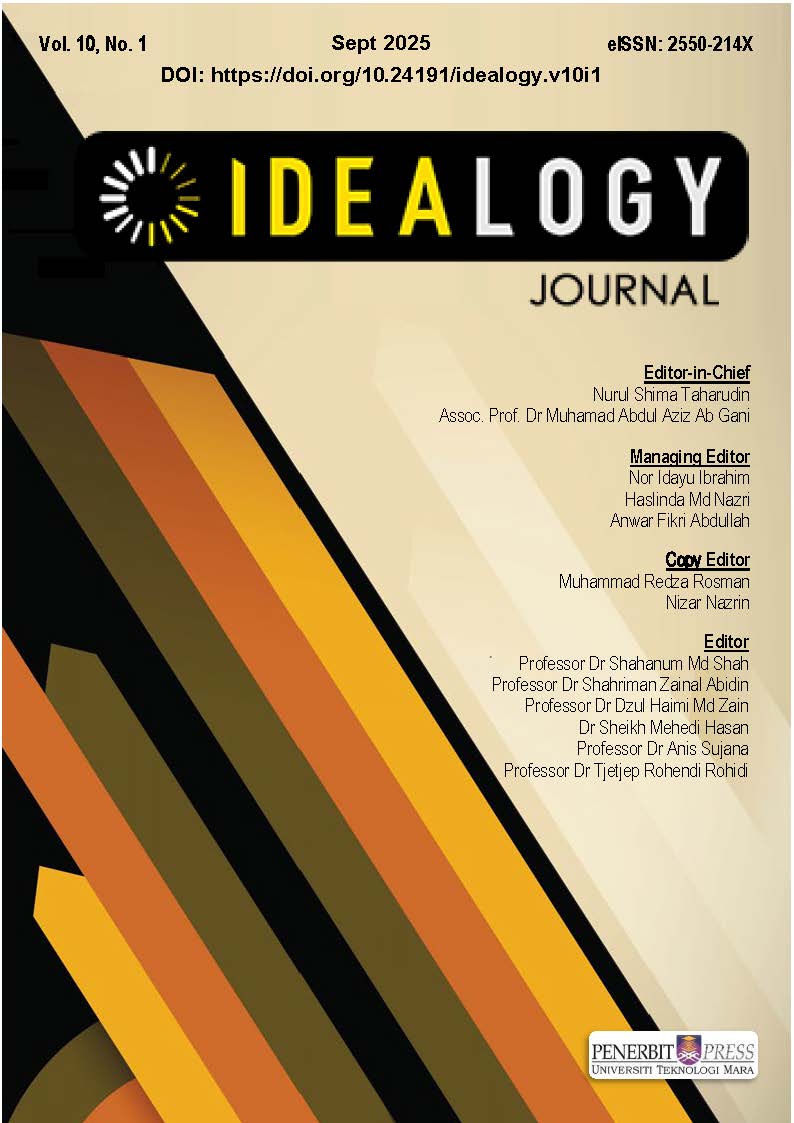Decoding Tradition: Culinary Techniques and Cultural Significance in MSS 2926
DOI:
https://doi.org/10.24191/idealogy.v10i1.717Keywords:
Cooking techniques, Cooking methods, Culinary, Malay, ManuscriptAbstract
This paper investigates MSS 2926, diving into its complex content to reveal the intricate culinary arts of the ancient Malay community. The study applies rigorous philological analysis to reveal the rich culinary information hidden in MSS 2926, which includes categories such as cooking requirements, materials, methods, equipment, measures, and important recommendations. It also investigates the manuscript's linguistic influence, which is distinguished by a strong fusion of Arabic and regional Malay, illuminating its cultural and linguistic relevance. By deciphering the complexities of MSS 2926 Cooking Tips, this study contributes to a better understanding of ancient Malay culinary practices and their long-lasting influence on current culinary discourse. The purpose of this article is to chronicle and analyse the culinary expertise preserved in MSS 2926, throwing light on its cultural and historical importance within Malay culinary traditions. The issue addressed is a lack of comprehensive investigation into the detailed culinary practices and linguistic influences included in MSS 2926, which impedes a proper understanding of traditional Malay cuisine. Using document analysis, this paper conducts a thorough examination of MSS 2926 to extract and analyse culinary traditions, and cultural insights buried within the document. The findings reveal a wealth of culinary information in MSS 2926, including precise cooking procedures, ingredient selection criteria, and the cultural fusion of Arabic and Malay influences, all of which contribute to a better understanding of traditional Malay cuisine. This study emphasizes the value of MSS 2926 as a tangible cultural heritage, providing insights into historic Malay culinary practices that continue to affect current culinary arts and cultural identity. It emphasizes the significance of keeping and researching such documents to protect and preserve cultural heritage and culinary diversity.
Keywords: Cooking techniques, cooking methods, Culinary, Malay, Manuscript
References
Abdul Rahman, Z. (2021). Cultural insights from MSS 2926: A study of Malay culinary practices. Malay Studies Review, 7(2), 89–104. https://doi.org/10.2345/msr.v7i2.345
Ahmad, R. H. (2021). Culinary traditions and manuscript studies in Malay culture. Journal of Cultural Heritage, 15(4), 101–123. https://doi.org/10.5678/jch.v15i4.7890
America's Test Kitchen. (2019). The complete vegetarian cookbook: A fresh guide to eating well with 700 foolproof recipes. America's Test Kitchen.
Barber, D. (2014). The third plate: Field notes on the future of food. Penguin Press.
Bowen, G. A. (2009). Document analysis as a qualitative research method. Qualitative Research Journal, 9(2), 27–40. https://doi.org/10.3316/QRJ0902027
Che Lah, M. R., & Zainal Abidin, N. (2023). Manuscript studies and culinary heritage: MSS 2926 Petua Memasak. Journal of Southeast Asian Culinary Studies, 15(1), 45–68. https://doi.org/10.2345/jsacs.v15i1.789
Gossling,S & Hall,M,C. (2022). The Sustainable Chef: The Environment in Culinary Arts, Restaurant, and Hospitality. Retrieved from Routledge Taylor& Francis Group. https://api.pageplace.de/preview/DT0400.9781351740241_A42120533/preview 9781351740241_A42120533.pdf
Hussain, S. (2018). Arabic influence on traditional Malay manuscripts. Southeast Asian Studies Review, 6(1), 65–89. https://doi.org/10.2346/sasr.v6i1.456
Ibrahim, Z., & Noor, N. M. (2020). Traditional Malay manuscripts: The culinary knowledge of MSS 2926 Petua Memasak. Journal of Malay Studies, 12(2), 34–56. https://doi.org/10.1234/jms.v12i2.5678
Keller, T. (2001). The French Laundry cookbook. Artisan.
McGee, H. (2004). On food and cooking: The science and lore of the kitchen (2nd ed.). Scribner.
Nosrat, S. (2017). Salt, fat, acid, heat: Mastering the elements of good cooking. Simon & Schuster.
Schafer, G. (2024). Worldly Flavors: A culinary Journey Through Global Cuisine. Independently published.
Stewart, J. (2019). Cool cooking techniques from around the world. The Discoverer.https://www.thediscoverer.com/blog/cool-cooking-techniques-from-around-the-world/XvHyVpKgiwAG5avZ
Strauss, A., & Corbin, J. (1998). Basics of qualitative research: Techniques and procedures for developing grounded theory (2nd ed.). Sage.
Sulaiman, M. S. (2018). Traditional Malay manuscripts: A source for culinary studies. International Journal of Malay World Studies, 3(4), 98–123. https://doi.org/10.5678/ijmws.v3i4.456
Waters, A. (2007). The art of simple food: Notes, lessons, and recipes from a kitchen in the country. Clarkson Potter.
Yin, R. K. (1994). Case study research: Design and methods (2nd ed.). Sage.
Yunus, N. M. (2021). Preserving traditional culinary knowledge: The role of Malay manuscripts. Heritage Studies Journal, 9(1), 30–48. https://doi.org/10.2345/hsj.v9i1.890
Yusof, S. M., & Abdullah, R. (2020). Preservation and digitization of traditional Malay culinary manuscripts. Journal of Archival Studies, 12(4), 176–195. https://doi.org/10.2345/jas.v12i4.678
Downloads
Published
Issue
Section
License
Copyright (c) 2025 Idealogy Journal

This work is licensed under a Creative Commons Attribution-NonCommercial-NoDerivatives 4.0 International License.
UiTM Press (the Publisher) has agreed to publish the undersigned author’s paper in Idealogy Journal. The agreement is contingent upon the fulfilment of a number of requirements listed below.
1. The undersigned author warrants that the paper entitled below is original, that it is not in any way libellous or unlawful in Malaysia, that it does not infringe any copyright or other proprietary right. The undersigned hereby represents and warrants that he/she is the author of the paper, except for material that is clearly identified as to its original source, with permission notices from the copyright owners where required. The undersigned represents that he/she has the power and authority to sign and execute this agreement.
2. The undersigned author warrants that the paper entitled below has not been published elsewhere, and also it will not be submitted anywhere else for publication prior to acceptance/rejection by this Journal.
3. By submitting the paper entitled below, the undersigned author agrees to transfer the rights to publish and distribute the paper in an international e-journal (entitled above) to Publisher.
4. The undersigned author agrees to make a reasonable effort to conform to Publisher's submission guidelines and to liaise with the editor to ensure that the requirements of these guidelines are met to a reasonable degree.
5. The corresponding author signs for and accepts responsibility for releasing this material on behalf of any and all coauthors. This agreement is to be signed by at least one of the authors who has obtained the assent of the co-author(s) where applicable. After submission of this agreement signed by the corresponding author, changes of authorship or in the order of the authors listed will not be accepted.


